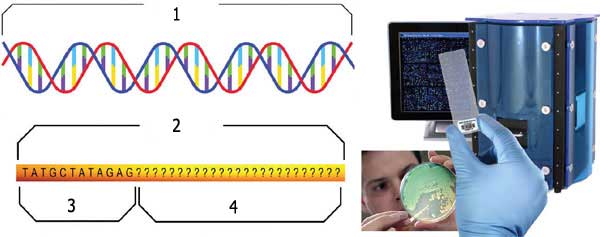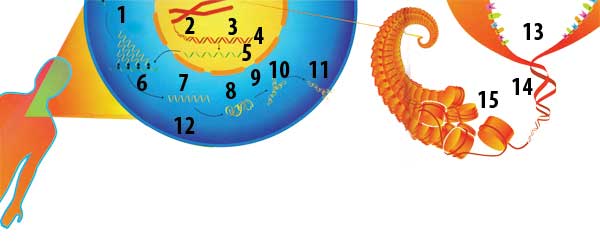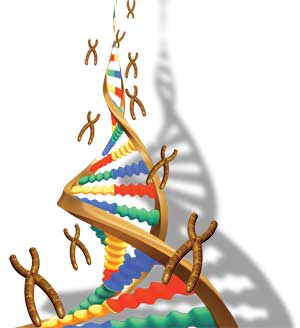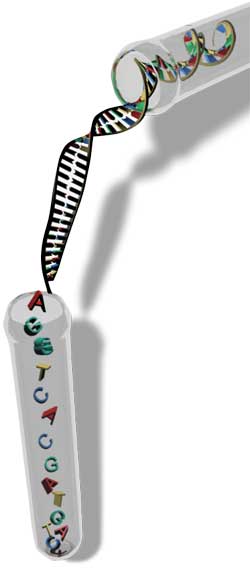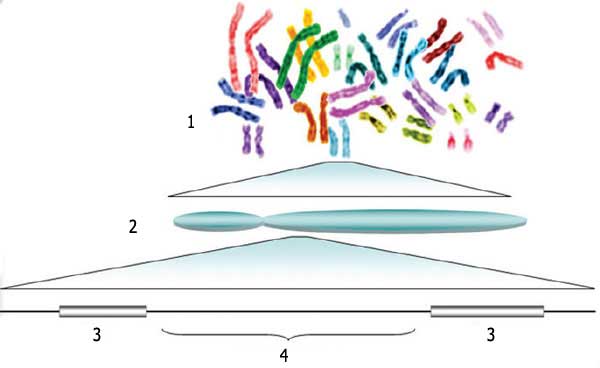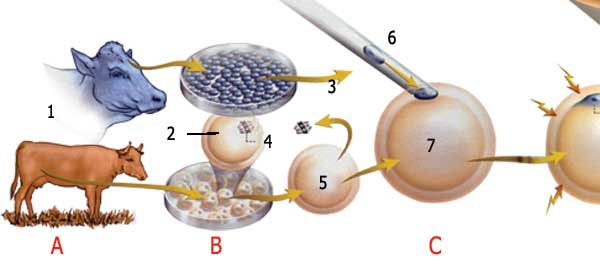Bigotry: The Dark Danger
If Darwin Had Known about DNA

DOWNLOAD THE BOOK
CHAPTERS OF THE BOOK
- From the Depths of the Universe to the DNA Molecule
- The Most Advanced Data Bank Known: DNA
- Aspect of The Cell Discovered In the 20th Century
- The Source of the Data of Life
- The DNA Molecule's Miraculous Structure
- DNA's Extraordinary Data-Storage Capacity
- The Cryptography in the DNA Molecule
- Protein Synthesis: The Matchless Production System Recorded in DNA
- The World's Most Advanced Copying Technology
- The Building Plan Recorded in Human DNA
- Darwinist-Materialist Errors Regarding the Human Genome Project
- The Information in Living Structures and The End of Materialism
- Some of Darwinism's Errors on the Subject of DNA
- How the Miracle of DNA Invalidates the Theory of Evolution
- DNA is an Example of Our Almighty Lord's Creative Artistry
< <
11 / total: 15
Darwinist-Materialist Errors Regarding the Human Genome ProjectGenome is the name for the entirety of the genetic information possessed by a cell--and thus, by a living thing. Hundreds of scientists in some 20 laboratories have been working for more than a decade to analyze the genetic information in the DNA molecule in each one of the 100 trillion or so cells in the human body. The Human Genome Project, run by an international body consisting of 16 institutions, aims to describe the whole of the genetic data inside the human cell and to read all the DNA texts written in genetic language. The biologists, chemists, engineers, computer scientists, mathematicians and experts in a great many other fields formed part of this international project, working to produce a biological map setting out human beings' physical characteristics. Yet despite all these efforts, the technology for recording the DNA sequence is still very slow, and recording the DNA sequence in a single human chromosome is a very expensive process--so expensive that some $2.7 billion has already been spent on the Human Genome Project,118 far more than was spent on sending man to the Moon and back. The draft of the human DNA sequence was completed in 2000. However, the project assumed its final form, with the correction of errors and completion of gaps, only in April 2003. The National Human Genome Research Institute, and the U.S. Departments of Energy and Health co-coordinated the 13-year Human Genome Project, some of whose objectives may be summarized:
The gene mapping technique employed in the project is to clarify where genes are located in the chromosomes, thus revealing the anatomy of a person's genome. With the mapping of the relative positions of a great many genes and other genetic markers along a chromosome, it is possible to produce a whole genome map. The mathematical analysis of the genome and a series of complex statistical analyses are employed to determine the location of genes on chromosomes, needed for us to understand the basic functions of the human body. One of the important objectives of the Human Genome Project is therefore the determination of the bases and causes of genetic diseases. It is hoped that with the data obtained from the project, an estimated 4,000 inherited diseases can be identified, and in the near future, therapy will be possible by means of the production of special drugs aimed at high-risk genetic diseases. The Size of Genes is No Measure of Their Complexity
It is very easy to misinterpret the enormous size of the human genome. The reason why human beings have 25 times more DNA than a fly is not because human beings are larger and more complex. There is no correlation in biological terms between the amount of genetic information and complexity. The single-celled organism Paramecium caudatum, , for instance, has 8.6 billion nucleotides, which is more than twice as many as the human genome. With 670 billion nucleotides, the single-celled Amoeba dubia possesses the broadest known amount of genetic information.119 Scientists working on the Human Genome Project state that they are still only beginning to understand the functions of genes and the relationships among them, because the emerging results were by no means what they had expected. For example, even a mouse or a stalk of wheat has longer DNA than human beings. This again shows that there is no direct correlation between DNA length and an organism's complexity. The biophysicist Dr. Lee Spetner refers to this:
It also emerged that previous estimates of the number of human genes were also incorrect. When their research began, scientists estimated that human beings had between 50,000 and 140,000 genes, but the latest studies established only between 25,000 and 30,000. This came as a considerable surprise to scientific circles. Francis S. Collins, head of the Human Genome Project, explains:
The difficulty here stems from Darwinist scientists constructing their claims on the assumption that humans are the most complex life form, for which reason they should have a greater number of genes. Since the human cell was a great deal more complex, it was expected to have a greater number of genes compared to the 6,000 in a yeast cell, 13,000 in the fruit fly, 18,000 in one species of worm and 26,000 in a plant species. However, the Human Genome Project invalidated the dogmatic logic that the more complex an organism, the larger its DNA and the number of its genes. Neither gene numbers nor DNA size shows evidence of evolution, though evolutionists are trying to distort this latest development, which really does work against them, and to depict it as proof of their theory! Due to both a lack of information and their prejudiced attitude, some media organizations also imagine that the Human Genome Project is uncovering proof of evolution, or else they seek to give that impression. Yet all the genetic findings obtained from the project have closed the doors field in Darwinism's face, as has happened in other branches of science. Evolutionists' Distortion of Genetic SimilarityWith the production of the human gene map, the findings from the Human Genome Project are being distorted and used as a propaganda tool in some evolutionist publications, claiming that there is a 98% resemblance between human and chimpanzee genes, which is proposed as evidence for evolution. In fact, however, these claims give no support to evolution; on the contrary, they are false evidence based on distortions. Even if there is a 98% resemblance between the chimpanzee and human genomes, it is illogical to infer that man is 98% chimpanzee. Human beings share specific genes with a great many other living things. For example, according to analyses carried in New Scientist magazine, a 75% resemblance has been determined between human DNA and that of nematode worms.122 However, this hardly means that human beings are 75% worm, or that there is only a 25% difference between them! Some evolutionists even see and speak of the illogicality of such inferences. Prof. Steven Jones issued a reminder if a 50% similarity is revealed between human beings and bananas, that will not mean that human beings are 50% banana. It is known that even if the genes in two life forms are the same, they can still work in entirely different ways. Moreover, genes are sometimes involved in more than one function, and one function is controlled by more than one gene. This broadens the mathematical difference to a very considerable extent. But analyses of various proteins show that human beings are very close related to very different life forms. In one study, researchers from Cambridge University compared the proteins of various terrestrial life forms. Astonishingly, in just about all the examples used, human beings and chickens turned out to be one another's closest relatives. Our next closest "relative" is the crocodile.123 Another example that evolutionists use to claim genetic similarity between man and ape is the fact that humans have 46 chromosomes, and chimpanzees and gorillas have 48. Evolutionists regard similarity between chromosome numbers as an indication of an evolutionary relationship. Yet if their logic were correct, man would have another relative just as close as the chimpanzee: the potato! The potato has exactly the same number of chromosomes as the chimpanzee and the gorilla: 48. On the other hand, the wild hare has exactly the same number of chromosomes as human beings: 46.124 These examples show that similar numbers represent no evidence at all for the theory of evolution, because genetic similarities do not fit the scenario claimed, but actually produce completely opposite results to it. The Darwinist media use information selectively, as propaganda tools. Since they claim that man and ape descended from a common ancestor, they emphasize the resemblance between the two species' DNA. Yet there are a number of studies –again carried out by evolutionists!– showing the invalidity of the "98% similarity" claimed by evolutionists for so many years. But these studies are deliberately not reported, or else given only very limited coverage.
A report titled "Humans, chimps more different than thought," carried on the CNN website on 25 September, 2002, reported the findings of this research:
On 23 September, 2002, the website of the British magazine New Scientist reported on the same subject, under the caption "Human-Chimp DNA Difference Trebled":
In conclusion, the genome project has revealed no findings in favor of the theory of evolution. On the contrary, it shows that on the basis of DNA and gene structures, no evolutionary tree of life can be constructed between living things. This deals a severe blow to Darwinism. Living things' DNA codes clearly show that the tree of life, imposed as the truth ever since the 19th century, is actually specious. The real aim of those sections of society blindly devoted to Darwinism is not to publicize the facts, but merely to propagate Darwinism. However, all the foundations on which their propaganda is built are crumbling away with ongoing scientific discoveries. Confronted by this, increasing numbers of people are realizing that the theory of evolution was a deception perpetrated for ideological reasons. In its place, the fact of creation is spreading rapidly. In the Qur'an, Allah reveals as follows: Do not mix up truth with falsehood and knowingly hide the truth. (Surat al-Baqara, 42) Rather We hurl the truth against falsehood and it cuts right through it and it vanishes clean away! Woe without end for you for what you portray! (Surat al-Anbiya, 18) Scientists Still Have Insufficient InformationAlthough scientists across the world have been working on the human genome for decades, our knowledge of genetic structure is still very limited. Scientists working for the Celera company, using advanced laboratory technology and computer analysis techniques, identified 26,500 human genes and provided estimated locations for around 13,000 of them. Using a different method, the Human Genome Project estimated that there are 31,778 human genes. What these two methods agree on is that human beings have between 30,000 and 40,000 genes. Given the complex nature of human genes, it is presently impossible to provide an exact number.
According to Human Genome Project estimates, those sections of DNA concerned with instructions for the production of protein represent less than 5% of the DNA sequence. The remaining genetic information consists of genetic control regions regarding chromosomes and DNA segments that are not yet understood.127 A great deal more research is needed before we can fully understand human genetic data. As scientists seek to reveal how the genetic mechanism functions, they cannot explain how such a perfect system came to be. Under the caption "Messages from the Genome" in the December 2000 issue of Harper's Magazine, Arthur Cody describes the operations within the genome as a series of "triggering processes" and then poses the following questions:
To the writer's questions, there is only one answer, of course: all these things take place under the inspiration of Almighty Allah. By the will of our Lord, billions of atoms combine together in such a way as to comprise all the functions of life. Indeed, with the conclusion of the Human Genome Project, the details of the genetic information that reveals the sublime creation with which Allah brings living things into being have been revealed for all to see. Today, anyone who examines the results of the project and discovers that in a single human cell is sufficient information to fill thousands of encyclopedia pages will see this as evidence of a magnificent creation. One of those who express this fact is the physicist and geneticist Prof. Francis S. Collins, leader of the Human Genome Project and head of the National Human Genome Project Research Institute. In 2005, Prof. Collins was awarded the Allen Prize, regarded as the American Society of Human Genetics' most prestigious award, for his lifetime's study of human genetics. In a speech, Prof. Collins stated that his studies had deepened his faith in Allah:
Any honest scientist will admit that faith and science are compatible with each other and that the universe is full of proofs of Allah. However, the dishonest approach adopted by the Darwinist-materialist media clearly demonstrates their selectivity. The words of this scientist, who headed the Human Genome Project and who confessed his amazement at the superior organization manifested in DNA--and how a single molecule strengthened his faith--appear nowhere in the press. However, the perfection in the order created by Allah is far too apparent to be concealed in any way. In the Qur'an, Allah reveals the attitude of believers: Those who have been given knowledge see that what has been sent down to you from your Lord is the truth and that it guides to the Path of [Allah], the Almighty, the Praiseworthy. (Surah Saba, 6) There is an excellent example in them for you to follow that is for those whose hope is in Allah and the Last Day. But if anyone turns away, Allah is the Rich Beyond Need, the Praiseworthy. (Surat al-Mumtahana, 6)
The Successes of the Human Genome Project are Part of the Destiny Created by AllahIn the wake of the conclusion of the Human Genome Project, certain publications began spreading misleading messages to cover up the impasse in which the theory of evolution found itself. One of the subjects brought up under different slogans and captions most frequently by the Darwinist-materialist press is the claim that the discovery of the gene map will supposedly be able to alter people's destinies. It is a grave error to spread messages such as "Man will no longer be a victim of fate" together with information about the human gene map. In fact, the map's completion will definitely make no difference to human destiny, because the map itself is also part of that destiny. Allah reveals this fact in the Qur'an: But you will not unless Allah wills. Allah is All-Knowing, All-Wise. (Surat al-Insan, 30) Destiny is the way that Allah knows all things in the past and present in the form of a single moment. Allah knows beforehand all things that have not yet taken place. A great many people fail to understand how He knows events that have not yet taken place. But the destiny that a person has not yet encountered is simply an event that, for that person, has not yet taken place. All events described as of "unknown" result are unknown to us alone. Omniscient Allah is unfettered by time and space. For that reason, the past, present and future are all one for Him, for He is the One Who created time and place. In the Sight of Allah, everything we are experiencing at this moment and everything we will experience in the future are all already over and done with. When the time comes, all humans witness the destiny created for them by Him.
In the same way that someone who holds the CD of a film can perceive the film's beginning, middle and end as a single disk, so Allah is aware of everything to come for all the human beings He has created. He Who knows all things as a single moment, shows us the infinite nature of His might by creating limitless infinity of time in that single infinitely small instant. In the face of these scientific developments, believers must be aware that all knowledge belongs to Allah, its real and only owner, as is revealed in the Qur'an: They said, "Glory be to You! We have no knowledge except what You have taught us. You are the All-Knowing, the All-Wise." (Surat al-Baqara, 32) He creates the lives of all human beings who have ever lived, together with all the details thereof. All events that may appear positive or negative and that people will encounter from birth until the moment of their death take place with Allah's knowledge. In Surat al-An'am, we are informed that everything that happens in the world, both great and small, does so at Allah's choosing: The keys of the Unseen are in His possession. No one knows them but Him. He knows everything in the land and sea. No leaf falls without His knowing it. There is no seed in the darkness of the Earth, and nothing moist or dry which is not in a Clear Book. (Surat al-An'am, 59) This applies to everyone and everything. Nobody can intervene in the destiny created for them by Allah, nor make the slightest alteration in the course of events. For example, Allah has created everyone and everything with a specific life span; and the moment, place, time, and form of that death are already set out in His Sight. When a person falls ill, that too has been determined billions of years before they were ever born. Whether they will recover from that illness is also set out in their destiny. Everything that can play a part in their recovery--doctors, nurses, hospitals, drugs and therapies--have all been written down beforehand in His sight. Therefore, if a person recovers, that does not mean that they changed their destiny, but that recovery was ordained beforehand. In the verses, Allah reveals: Your Lord knows you best. If He wills, He will have mercy on you, and, if He wills, He will punish you. We did not send you to be their guardian. My Lord knows best everyone in the heavens and Earth. . . . (Surat al-Isra, 54-55) One day in the future, if people's lives are extended through direct intervention in their genes, this does not mean that they interfered in their own destiny. What it means is that Allah created them with long life spans, and the production of the gene map is the means whereby their lives can be lengthened. The fact that the person is living at a time of technological advances in genetics, and the prolongation of life through medical means are all a part of destiny: Everything is determined in the sight of Allah long before the person even comes into the world. Similarly, someone with a potentially fatal disease who is cured as a result of medical discoveries lives his destiny as well, because being cured is also in his destiny. The production of the human gene map and the means of intervening in humanity's genetic makeup do not oppose the destiny created by Allah. On the contrary, humanity is following the course created for it, using information created by Him. If, thanks to these scientific advances, someone lives to the age of 120, that is the age appointed beforehand by Allah, and that is how long the person will live. In one verse, Allah reveals that everyone's life span is determined in a book in His Sight: Allah created you from dust and then from a drop of sperm and then made you into pairs. No female becomes pregnant or gives birth except with His knowledge. And no living thing lives long or has its life cut short without that being in a Book. That is easy for Allah. (Surah Fatir, 11) In short, such expressions such as "cheating fate" and "changing one's destiny" are inaccurate terms stemming from ignorance of the fact of destiny. Even the fact that someone will employ these expressions when they speak is determined beforehand in their destiny. It has already been determined in the sight of Allah where, when and under what circumstances a person will use them. Allah is aware of all things. He has revealed that all things are written in a book in His Sight. We live just what is written in that book, no more and no less. … Whom not even the weight of the smallest particle eludes, either in the heavens or in the Earth; nor is there anything smaller or larger than that which is not in a Clear Book. (Surah Saba, 3) Nothing occurs, either in the Earth or in yourselves, without its being in a Book before We make it happen. That is something easy for Allah. (Surat al-Hadid, 22)
Evolutionist Misconceptions About Genetic EngineeringGenetic engineering isolates genetic materials from one living thing, and transfers them into another organism. By this means, scientists are able to clone living things, develop plants resistant to disease and insects, and produce bacteria that digest industrial wastes. However, neither these biotechnological studies nor the genetic research they are based on support the theory of evolution. The main errors of those who claim otherwise can be summarized: 1) Biotechnological research proves that living things are not the result of random, unconscious events, but were intelligently created: In all genetic studies, genes are worked on with great care. In other words, conscious intervention takes place. Scientists who manipulate genes in line with a specific purpose have learned about the functioning of the cell through many years of training. All the stages of the research are performed with enormous care, and are controlled by laboratories, using technological equipment, in specially regulated environments. Despite being an evolutionist, Professor of Biology William D. Stansfield cites an example of cell synthesis in the laboratory to show that studies of this kind cannot represent proof of evolution:
2) Genetic variations provides no support for the theory of evolution: Contrary to what is claimed in evolutionist publications, experiments resulting in genetic variation are no evidence for the theory of evolution. The theory of evolution maintains that there are mechanisms in nature that turn living things into more complex ones, by which means one species turns into another. In fact, experiments in the field of genetic engineering and biotechnology have demonstrated that it is impossible for genetic variation to give rise to any change of species. Some evolutionists ignore this, however, playing with words to make unrealistic claims that the theory of evolution has been proven in the laboratory. 3) Organisms developed using genetic engineering are no evidence for the theory of evolution:
Another error is the claim that new organisms developed through genetic engineering confirm the theory of evolution. The methods currently employed in the field of genetic engineering and biotechnology-particularly in such areas as the production of drugs or proteins such as insulin or altering the reaction speeds of various enzymes-are portrayed by evolutionists as evidence for the theory of evolution. In fact, it is impossible for these studies to constitute any such evidence. Genetic engineering studies proceed through the development of recombinant DNA technology, which recombines various genes that already exist. That being so, evolutionists must first account for the origin of genes, the raw materials of their genetic engineering. (See Chapter X, "How Does the DNA Miracle Invalidate the Theory of Evolution?) Already facing a complete impasse on the subject of DNA's origin, evolutionists placed their hopes in research on genetic engineering. But since the theory of evolution claims that living species came into existence solely through chance mechanisms, evolutionist interpretations of genetic engineering are flawed from the outset. In their claims concerning genetic engineering, evolutionists exhibit a serious contradiction. Attempts are made to use the fact that genes can be transferred between different organisms, or that genes can be recombined, as evidence of an evolutionary process. But as you have seen in previous sections, genes' highly complex structures are a most powerful proof that no such random process ever took place.
4) Genes show that living things share a common origin, not a common ancestor: Another of the errors in the evolutionist propaganda regarding this research is that common genes that can be transferred between organisms prove the claim that living things are descended from a common ancestor. After describing how they are able to transfer genes between different species, Darwinist researchers then go on to claim that they can do so because the living things are descended from a common ancestor. People with a superficial knowledge of the subject are misled by the way analysis based on evolutionists' assumptions is portrayed as proof. In fact, a common origin constitutes no evidence for a common ancestor. Nor does the fact that genes can be transferred among different organisms prove that biologic structures evolved by chance, through haphazard natural events. Objectively, the common genes in different organisms may be regarded as an indication of common origin-which clearly supports the fact of creation. 5) Genetic engineering provides no support for atheist propaganda: Commentaries regarding genetic engineering suggest that this is actually creating. Materialists who deny the existence of Allah use genetic engineering research to support their atheist propaganda and interpret recombinant studies as creation. (Allah is beyond this.) Atheists refuse to grasp that "creation" means bringing something into being from nothing. Creation belongs to Allah alone. In their genetic engineering studies, scientists make changes in genes that have been created by Allah, or else transfer these between living things also created by Him in the first place. The genetic information used to develop new "hybrids" in these studies already exists in the living world. For example, scientists can make a zebra fish emit light by implanting a luminous jellyfish gene into it, or to bring about the production of spider silk in goat's milk by implanting spider DNA into a goat. But even though the resulting life forms may appear to possess various new characteristics, no new genetic information has been created; all that has happened is that existing information has changed places among living species. Even if scientists one day manage to radically restructure a living creature, this will still apply. The molecular biologist Michael Denton expresses this fact:
In conclusion, evolutionist statements about genetic engineering are invalid. On the contrary, research in this field with its planned and controlled environments and deliberate changes, reveals that living things have been created with a perfect organization.
Why Cloning Provides No Support for the Theory of EvolutionDuring the cloning process, DNA from a cell from the organism planned to be duplicated is placed under the microscope and implanted into an egg of another of the same species. The DNA of the organism whose copying is being planned is employed for this process. Immediately afterwards, an electric shock causes the egg cell to start dividing. The developing embryo is placed inside the womb of a female member of that particular species, and its growth and birth are then awaited. First off, cloning and evolution are completely different concepts. The theory of evolution is based on the claim that life came into existence from inanimate matter as the result of chance (though there is absolutely no evidence to suggest that this claim might be true). Cloning, on the other hand, is the replication of a living thing by using genetic material from a living cell-a biological process repeated by artificial means in a laboratory environment. In other words, there is no chance process, nor of inanimate matter coming to life-on which the theory of evolution depends. In fact, the replication process is manifest proof of a biological law that completely undermines evolution. That law is the principle that "Life arises from life" advanced in the late 19th century by the famous scientist Louis Pasteur. The depiction of cloning as evidence for evolution in the face of this evident fact is a major distortion perpetrated by certain sections of the media.
Advances in various scientific fields, particularly over the last 30 years, have shown that it is impossible to account for the emergence of living things in terms of chance. Evolutionists' scientific errors and biased analyses have been documented, and the theory of evolution has become indefensible within the requirements of science. This has propelled evolutionists to look for other solutions, which is the reason for the propaganda around such scientific advances as the "copying of life" and "test-tube babies" being portrayed as proofs of evolution. Another misconception is the idea that cloning means creating a new life form. The fact is, cloning consists of an already existing reproductive mechanism being joined to previously existing genetic information. No new mechanisms or genetic data are produced during this procedure. Genetic information is extracted from an organism that already exists-a sheep, for example-and is then implanted into the womb of a female sheep. The lamb is thus a "younger twin" of the sheep from which the genetic information was extracted. This has nothing to do with theory of evolution, nor with the concept of creating a living thing from scratch. Creating a human being or any other living thing-bringing them into existence from nothing-is unique to Allah alone. Scientific progress confirms this by showing that it is impossible for human beings to perform such creation. In one verse it is stated that: The Originator of the heavens and Earth. When He decides on something, He just says to it, "Be!" and it is. (Surat al-Baqara, 117) Evolutionists are left with nothing scientific to say, but still attempt to keep their theory alive by hiding behind popular scientific ignorance, thus making that theory's lack of credibility crystal-clear. Like all other important scientific advances, cloning is a very illuminating development revealing that life was created.
Footnotes118. http://www.genome.gov/11006943 119. W.-H. Li, D. Graur, Fundamentals of Molecular Evolution, Sinauer Associates, Inc., Sunderland, 1991, p. 209. 120. Lee Spetner, Not By Chance, Shattering the Modern Theory of Evolution,p. 28. 121. Francis S. Collins, "Faith and the Human Genome Project", Perspectives on Science and Christian Faith, cilt. 55, no. 3, Eylül 2003, s. 146.; http://www.asa3.org/ASA/PSCF/2003/PSCF9-03Collins.pdf 122. Karen Hopkin, "The Greatest Apes", New Scientist, 15 May 1999, no. 2186, p. 26. 123. New Scientist, Vol. 103, 16 August 1984, p. 19. 124. http://en.wikipedia.org/wiki/List_of_number_of_chromosomes_of_various_organisms 125. "Human, Chimps More Different Than Thought", The Associated Press, 24 September 2002, http://lists.ibiblio.org/pipermail/monkeywire/2002-September/000250.html. 126. Andy Coghlan, "Human-chimp DNA Difference Trebled", New Scientist, 23 September 2002; http://www.newscientist.com/news/news.jsp?id=ns99992833 127. J. C. Venter, et. al., "The Sequence of the Human Genome," Vol. 291, 2001, pp. 1304-1351. 128. Wayne Jackson, "Mapping the Human Genome: Does It Prove Evolution?", Christian Courier, 1 April 2001; http://www.christiancourier.com/feature/april2001.htm 129. Francis S. Collins, "Faith and the Human Genome Project", Perspectives on Science and Christian Faith, http://www.asa3.org/ASA/PSCF/2003/PSCF9-03Collins.pdf (emphasis addded) 130. William D. Stansfield, The Science of Evolution, Macmillan, New York, 1983, 8th Edition, pp. 10-11. 131. Michael Denton, Nature's Destiny, Free Press, 1998, p. 321.
|
||||||||||||||||||||||||||||||||||||||||
11 / total 15
You can read Harun Yahya's book If Darwin Had Known about DNA online, share it on social networks such as Facebook and Twitter, download it to your computer, use it in your homework and theses, and publish, copy or reproduce it on your own web sites or blogs without paying any copyright fee, so long as you acknowledge this site as the reference.


